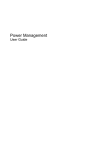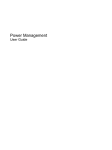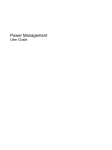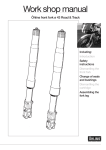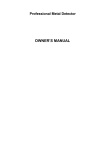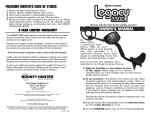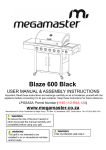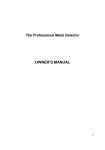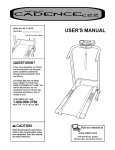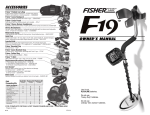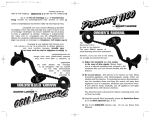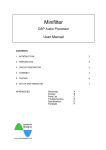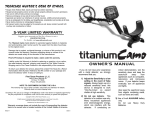Download The Most Advanced Metal Detector
Transcript
The Most Advanced Metal Detector This metal detector is a professional metal detector. As a sophisticated electronic device, the most difficult aspects in metal detecting have been automated. If you are fresh in using metal detector, we highly recommended you: 1. Set the sensitivity to a low level in the event of false signals. Always begin at a reduced sensitivity level when using. After you have become familiar with the detector, you may try it at full sensitivity. 2. This detector is for outdoor use only. Do not use indoors. Many home appliances can emit electromagnetic wave, and will interfere with the detector. For indoor testing, turn the sensitivity down and keep the search coil away from facilities such as microwave ovens, computers and TVs. If your detector beeps erratically,turn off the electronic appliances and lights, especially those with dimmer switches. 3. Read this manual. Most importantly,review the BASIC OPERATION.(P. 8) .1. CONTENTS Terminology Assembly . . . . . . . . . . . . . . . . . . . . . . . . . . . . . . . . . . . . . . . . .3 . . . . . . . . . . . . . . . . . . . . . . . . . . . . . . . . . . . . . . . . .4 Control Panel . . . . . . . . . . . . . . . . . . . . . . . . . . . . . . . . . . . . . . . . . .6 Basic Operation . . . . . . . . . . . . . . . . . . . . . . . . . . . . . . . . . . . . . . . 8 In the Field Technique . . . . . . . . . . . . . . . . . . . . . . . . . . . . . . . . .13 Care and maintenance. . . . . . . . . . . . . . . . . . . . . . . . . . . . . . . . .19 .2. 1TERMINOLOGY The following terms are used throughout the manual, and are standard terminology among detectorists. · ELIMINATION - Reference to a metal being "eliminated" means that the detector will not emit a tone, nor light up an indicator, when a specified object passes through the coil’s detection field. · DISCRIMINATION - When the detector emits different tones for different types of metals, and when the detector "eliminates" certain metals, we refer to this as the detector "discriminating" among different types of metals. Discrimination is an important feature of professional metal detectors. Discrimination allows the user to ignore trash and otherwise undesirable objects. · NOTCH - Notching is the elimination of an item, or range of items, within the metallic spectrum. We “notch-out” an object, or objects, selectively. · AUTO NOTCH - It eliminates trash metals automatically and keep the detection for most coins. AUTO NOTCH range is preset in the factory and not adjustable.. · RELIC - A relic is an object of interest by reason of its age or its association with the past. Many relics are made of iron, but can also be made of bronze or precious metals. · IRON - Iron is a common, low-grade metal that is an undesirable target in certain metal detecting applications. Examples of undesirable iron objects are old cans, pipes, bolts, and nails. Sometimes, the desired target is made of iron. Property markers, for instance, contain iron. Valuable relics can also be composed of iron; cannon balls, old armaments, and parts of old structures and vehicles can also be composed of iron. · · FERROUS - Metals which are made of, or contain, iron. GND TRAC - Ground Track is the process of finding the exact location of a buried object. Long-buried metals can appear exactly like the surrounding soil, and can therefore be very hard to isolate from the soil · PULL-TABS - Discarded pull-tabs from beverage containers are the most bothersome trash items for treasure hunters. They come in many different shapes and sizes. Pull-tabs can be eliminated from detection, but some other valuable objects can have a magnetic signature similar to pull-tabs, and will also be eliminated when discriminating out pull-tabs. · GND BAL - Ground Balancing is the ability of the detector to ignore, or "see through," the earth’s naturally occurring minerals, eliminates false signals from severe ground conditions, and only sound a tone when a metal object is detected. · SURF ELIM - Surface Elimination can improve the accuracy of detection result in soil with mass trash metal. It restrains the signal from trash metal in soil surface layer, and balance the signal from large target. .3. 2ASSEMBLY 2 1 ASSSEMBLY Assembly is easy and requires no tools 1 Open the packing, and take out all parts. Join the search coil and the lower stem (fiberglass-made, in black color) then tighten the bolt. 3 Press the silver button on the upper end 2 of the lower stem, and slide the lower stem into the upper stem. Adjust the stem to a length that you feel comfortable when you stand upright with the detector in your hand, and the search coil is level with the ground with your arm relaxed at your side. Then counter-clockwise rotate to tighten the lock cam. 4 Wind the search coil cable around the stem. Insert the search coil’s plug into the search coil jack on the detector’s control housing. Caution: · Do not over-tightenthe searchcoil or use tools The search coil’s plug fits into the connector only in one way. Do not force the plug such as pliersto tightenit. and also do not pull on the cable or you could damage it. .4. 5 Assembly the arm support: Press the silver button on the upper end of the stem and insert the aluminum end of the arm support. Make sure the silver button pop up physically. Adjusting the arm support Standard position of the arm rest usually is comfortable for most people. Very large forearms and short forearms (particularly children’s arms), can be accommodated by adjusting the arm rest accordingly.The arm rest is adjustable to three positions. To adjust, remove the screw from the underside, then move the arm rest to one of the alternate positions and re-install the screw. Caution 2 2 BATTERIES · This metal detector uses two 9-Voltalkaline batteries (not supplied). · Using only fresh and proper alkaline batteries is recommended · Do not mix the old and new batteries or different types of batteries. Installation 1. Be sure the power switch is at off-position. 2. Slide the battery cover off in the direction of the arrow. 3. Takeout two battery connectors from the compartment. 4. Join the battery polarities with the connectors. 5. Re-install the battery cover. Warning Dispose of old batteries promptly and properly,do not bury or burn the batteries. Note · If you don’t plan to use the unit for a week or more time, remove the batteries. Batteries can leak chemicals that can destroy electronic parts. ·To extend the battery lift, exchange the left and right battery after 3-4hours of operation. · “LOW BATT” will display on bottom right corner of the LCD, it’s the time to change the batteries. .5. 3Control Panel 3 1 LCD Indicators Operating Mode Indicator Status Indicator Sensitivity(SENS) Indicator Depth Indicator DISC/NOTCH Range Indicator TargetIndicator DISC,ALL METAL,NOTCH, AUTO-NOTCH. Status Indicator shows current machine status SENS adjustment, DISC range adjustment or NOTCH range adjustment SURF-ELIM selected or not and lowbattery or not. Sensitivity Indicator(SENS) indicates current sensitivity degree of the machine. Depth Indicator shows target depth DISC/NOTCH Range Indicator indicating current DISC/NOTCH range settings. TargetIndicator shows the target category Operating Mode Indicator shows current operating mode, among the 4 operating modes the detector has .6. 3 2 Controllers’ Quick Introductions (Details see 4. BASIC OPERATION) MODE — interchanging the operating mode. 2 ADJUST + —,ENTER — adjusting the sensitivity,DISC or NOTCH range. 3 SURF ELIM — turning the detector into surface elimination mode. 4 GND TRAC,GND BAL — setting ground balance in ALL METAL mode and 1 pinpointing a target. 5 VOL controller — power switch of the metal detector, also used for controlling the detector’s volume . .7. 4BASIC OPERATION 4 1 Motion and Non-motion Modes 1. ALL METALMode is a non-motion mode In this mode, metal is detected with the coil motionless over the ground, and the detector emits only a monotone sound — No need to move the coil from side to side. In ALL METALMode, adjust GND BAL controller and then press GND TRAC several times to eliminate ordinary minerals and ores. Metal detector sounds in middle tone to all targets detected in ALL METALmode. 2.DISC,NOTCH and AUTO-NOTCH Modes are motion modes There’re 3 tones to identify different metals in these modes. Detector can work in auto-ground balance. Sensitivity is adjustable – while GND BAL is useless in this mode. To reject the trash metal, you may adjust DISC or NOTCH range. Motion mode means the coil must be in continuous motion, otherwise target cannot be detected. 4 2 Power On Clockwise rotate the VOL knob from off-position to power on the detector. The machine runs a self-test All display segments will illuminate and the detector sounds high medium and low tones respectively. , then stays in DISC mode after first 2~3seconds. 4 3 Four Operating Modes Interchange among 4 operating modes DISC, ALL METAL, AUTO-NOTCH, NOTCH. Press MODE touch pad to change the operating modes in following order: DISC→ALL METAL→AUTO-NOTCH→NOTCH→DISC……The operating mode displays at bottom left corner of the LCD. 1. DISC mode—Power up the machine, and it enters into DISC mode automatically. In addition, the PROBABLE depth of coin-sized objects is indicated by the rectangular segment indicators on the left side of the display. All detected objects will cause the depth indicator to illuminate. The depth indication is not accurate for larger objects. In this mode, the detector can eliminate unwanted objects from detection among the categories on top of the panel from left to right. DISC/NOTCH indicator shows detector’s current .8. discrimination level, and an object’s probable identification is indicated by the arrows at the top of the display. SENS shows current sensitivity level. While DEPTH read the estimated target depth. Each time a target detected, DEPTH indicator will illuminate. DEPTH indicator is more accurate in relative depth, the larger the reading is, the farther the target away from the coil. Adjusting TargetDISC Range Press ADJ to enter the machine into DISC range setting status “DISC/NOTCH" at bottom right corner LCD displays then press“+” to increase the level of discrimination, and press “-” to decrease the level of discrimination. 2.ALL METALMode— Press MODE pad to enter into ALL METALmode, the detector now is in non-motion mode. In this mode, the machine emits only a monotone sound when finding a target, and DEPTH indicates relative target signal strength. The stronger the signal is, the louder the tone is. Pinpoint is used to locate a coin-sized object precisely.To move the coil above or near the target area, target will be found soon. Please make sure the detector is well ground balanced before using ALL METALmode. (Please refer to P.16 Ground Balancing and P.18 PINPOINTING at Non-motion mode ) Target identification is useless in ALL METAL mode. To see target identification and depth, please change the detector into relative motion mode. 3.NOTCH Mode— To selectively eliminate one or several metals from the categories, you can use NOTCH mode. DISC/NOTCH indicator shows current target discrimination level, and an object’s probable identification is indicated by the arrows at the top of the display. SENS shows current sensitivity level. While DEPTH indicates the probable target depth. Adjusting Target NOTCH Range In NOTCH mode, press ADJ to enter into DISC/NOTCH range setting status. LCD displays “DISC/NOTCH” at bottom right corner . Press + - touch pad , and one of the arrows in target indicator will flash, .9. press ENT to accept or reject the corresponding metal category. Press again+ - , its right (left) arrow will flash, then press ENT to accept or reject another metal category which the current arrow pointing to. Same as the others… 4.AUTO-NOTCH Mode— When detector is working in AUTO-NOTCH mode LCD shows “AUTO-NOTCH” at bottom side , it eliminates trash metals automatically and keep the detection for coins. Eliminated trash metals include: Bottle caps, S-CAPS, IRON/FOIL, Pull Tab. DISC/NOTCH range not adjustable displays current target identification range. And an object’s probable identification is indicated by the arrows at the top of the display. SENS shows current sensitivity level. While DEPTH indicates the probable target depth. 4 4 Sensitivity Adjustment Adjusting Sensitivity in DISC,NOTCH and AUTO-NOTCH MODE Press ADJ to enter into sensitivity setting status (LCD shows “SENS” at bottom right corner , press + pad to increase the detector’s sensitivity level, and press – to Sensitivity is not adjustable in ALL METALmode decrease the sensitivity. Note ELECTROMAGNETIC INTERFERENCE The principle use for the Sensitivity Control is to eliminate electromagnetic interference. This metal detector is an extremely sensitive device; the search coil creates its own magnetic field and acts like an antenna. If your detector beeps erratically when the search coil is motionless, the unit is probably detecting another electromagnetic field. Common sources of the electromagnetic interference are electric power lines, both suspended and buried, motors, and household appliances like computers and microwave ovens. Some indoor electronic devices, such as dimmer switches used on household lighting, produce severe EMI and can cause the detector to beep erratically. Other metal detectors also produce their own electromagnetic fields; so if detecting with a friend, keep two metal detectors at least 6 meters apart. SEVERE GROUND CONDITIONS A secondary use for the Sensitivity Control is to reduce false detection signals caused by severe ground conditions. Although this metal detector has specially designed circuit to .10. reduce the ground mineralization, the ground conditions in field hunting cannot be anticipated. Highly magnetic soils found in mountainous can cause the detector to emit tones when metal objects are not present. High saline content soils and sands can sometimes cause the detector to false. If the detector emits false, non-repeatable, signals, REDUCE THE SENSITIVITY. MULTIPLE TARGETS If you suspect the presence of deeper targets beneath a shallower target, reduce the sensitivity to eliminate the detection of the deeper targets, in order to properly locate and identify the shallower target. 4 5 Surface Elimination Press SURF ELIM to enter into or quit Surface Elimination mode. SURF ELIM only works in motion mode. SURF ELIM can improve the accuracy of detection result in soil with mass trash metal. It restrains the signal from trash metal in soil surface layer, and balance the signal from large target. But detector’s sensitivity is decreased in this mode. 4 6 Headphone Jack Using headphones(not supplied) with your metal detector makes it easier to identify subtle changes in the threshold levels for better detection results, and also reduces drain on the batteries. The metal detector has a stereo headphone jack located at the control panel. Caution: To protect your hearing, set the volume to the lowest setting before you begin listening. Extended high volume listening can lead to permanent hearing loss. .11. 4 7 ATI(AudioTargetIdentification) While the LCD (Liquid Crystal Display) is very accurate in identifying buried objects, the user in the field does not always maintain the display screen in his field of vision. Therefore, we have incorporated an audio feedback mechanism to alert the user to the nature of buried objects. This audio feedback system first alerts the user to the presence and classification of objects, whose nature and location can be confirmed using the LCD display. The 3-tone audio target identification system functions only in the motion modes of operation. The detector must be in the DISCRIMINATION, NOTCH or AUTONOTCH modes. In ALL METAL mode, the detector will emit only a monotone sound. The detector can sound three different tones, depending on the object detected. LOW TONE Bottle caps, nickel coins 5¢ smallest gold objects will induce a bass tone. MEDIUM TONE Pull-Tabs, S-CAPS, zinc coins, Newer pennies (post-1982), gold objects will induce medium tones. HIGH TONE 1¢(1950), 10¢, 25¢ and 50¢ fall into this category. .12. 5IN THE FIELD TECHNIQUE 5 1 1 READING THE DISPLAY TargetIndicator The Liquid Crystal Display (LCD) shows the PROBABLE identification of the targeted metal, as well as the PROBABLE depth of the target. The detector will register a repeating, unchanging target identification when a buried target has been located and identified. If, upon repeated passes over the same spot, the target identification reads inconsistently, the target is probably a trash item, or oxidized metal. With practice, you will learn to unearth only the repeatable signals. Also, the greater the distance between the target and the coil, the less accurate the target identification GOLD - Gold objects will register on the left side of the LCD scale. Gold will register depending upon its size. The smaller the gold object, the further to the left it will register. Gold flakes will register on the far-left side (under Iron), Large gold items will register under S-cap or Zinc IRON - Ferrous objects will register on the far-left side of the target identification scale. Objects in this category could be worthless scrap, or a more valuable iron relic. 5¢ - Nickels and most newer pull tabs (those that stay attached to the can) will register here. Pull-Tabs- Pull-tabs from older beverage cans will register here. Few newer pull-tabs will also register here. Many gold rings will also register here. S-CAPS - Screw bottle caps and some small gold will register here. 1¢ - 1¢(post-1982) or copper coin register here. SILVER 10¢/1¢ - 1¢ pre-1982 , 10¢ or aluminum coin. 25¢ - 25¢, some small silver coins, or large aluminum coins 50¢ - 50¢, or some large silver coins Note: The target indications are visual references. Many other types of metal can fall under any one of these categories. While this metal detector will eliminate or indicate the presence of most common trash items, it is impossible to accurately classify ALL buried objects. .13. 2 Depth Indicator The Depth Indicator is accurate for coin-sized objects. It indicates the relative depth of the target. Large and irregularly-shaped objects will yield less reliable depth readings. When passing over an object, the depth indicator will light up and stay illuminated until another object is scanned. Repeated indication at the same depth level indicates an accurate target detector. If the depth indication varies with each sweep, try sweeping at different angles; there may be more than one target present. With practice, you will learn the difference between accurate readings, multiple targets, and highly erratic readings which evidence trash or irregularly shaped objects. NOTE Depth indication is different for the same target in air from that under the ground. 5 2 INDOOR TEST Supplies Needed • A Nail • A Quarter • A 1¢(post-1982) 1. Turn on the detector. 2. Place the detector on a wooden or plastic table, and take off the watch, ring or other metal objects on your hand or arm. 3. Adjust the search coil so the flat part points upwards. 4. When the operating mode is in DISC Mode, NOTCH or AUTO-NOTCH mode, evenly sweep the nail 10-12cm above the flat face of the search coil. The detector will emit a low tone when detects the sample, and the arrow pointing to nail in target indicator illuminates. The DEPTH indicator also displays corresponding value. Repeat the above test with a1¢ (post-1982). Detector sounds medium tone this time, and target indicator arrow points to 1¢. While In the test of 25¢, detector emits high tone and arrow points to 25 ¢. NOTE When the sample is a coin, better let the flat side of the coin parallel with the flat face of the search coil, and sweep it evenly,so that the detector can find the target more easily. Have the narrow side of the coin parallel with the search coil will cause test error, and target arrow might be flash and jump. 5. In ALL METAL Mode, move a test sample above the flat side of search coil from a higher location (above than 1 foot) slowly close to the search coil. The detector emits a .14. tone when detects the target, and DEPTH indicator shows relative value. All samples sound one tone in this mode. 5 3 OUTDOOR TEST AND PRACTICE PINPOINTING motion mode Accurate pinpointing takes practice and is best accomplished by crossing sweep the target area. 1. Once a buried target is indicated by a good tone response, continue sweeping the coil over the target in a narrowing side-to-side motion. 2. Takevisual note of the place on the ground where the “beep” sounds. 3. Stop the coil directly over this spot on the ground. 4. Now move the coil straight forward and straight back towards you a couple of times. 5. Again make visual note of the spot on the ground at which the “beep” sounds. 6. If needed, cross sweep the target in “X” pattern at different angles to “zero in” on the exact spot on the ground at which the “beep” sounds. COIL MOVEMENT When swinging the coil, be careful to keep it level Correct with the ground about 1-1.5cm from the surface. Never swing the coil like a pendulum. Raising the search coil while sweeping or at the end of a sweep Wrong will cause false reading. When searching, it’s better you sweep the search coil from side to side in an arc line of 7-8cm motion. Swing the search coil slowly, overlapping each sweep as you move forward. It is important to sweep the coil at a consistent speed over the ground as you search. After identifying a target, your sweep technique can help in identifying both the location and the nature of the target. If you encounter a weak signal, try moving the coil in short, rapid sweeps over .15. the target zone; such a short rapid sweep may provide a more consistent target identification. Most worthwhile objects will respond with a repeatable tone. If the signal does not repeat after sweeping the coil directly over the suspected target a few times, it is more than likely trash metal. Crossing the target zone with multiple intersecting sweeps at multiple angles is another way to verify the repeatability of the signal, and the potential of the buried target. To use this method, walk around the target area in a circle, sweeping the coil across the target repeatedly, every 30 to 40 degrees of the circle, about ten different angles as you walk completely around the target. If a high-tone target completely disappears from detection at a given angle, chances are that you are detecting oxidized ferrous metals, rather than a silver or copper object. If the tone changes at different angles, you may have encountered multiple objects. If you are new to the hobby,you may want to dig all targets at first. With practice in the field, you will learn to better discern the nature of buried objects by the nature of the detector’s response. You may encounter some false signals as you proceed. False signals occur when the detector beeps, but no metal target is present. False signals can be induced by electromagnetic interference, oxidation, or highly mineralized ground soils. If the detector beeps once, but does not repeat the signal with several additional sweeps over the same spot, there is probably no target present. When searching very trashing ground, it is best to scan small areas with slow, short sweeps. You will be surprised just how much trash metal and foil you will find in some areas. The trashiest areas have been frequented by the most people, and frequently hold the most promise for finding the most lost valuables. 5 4 GROUND BALANCING Before using the ALL METALmode, it is necessary to “Ground Balance” your detector, this ground balancing adjustment offsets the effects of minerals and salts in the ground. To GROUND BALANCE your detector: .16. 1. Use the ALL METAL mode to find a patch of ground which is free of metal objects. Youwill use this section of ground to test the detector. The presence of any metal objects in this area will interfere with this procedure. 2. Lift the search coil waist high in the air. 3. Begin with the ground balance (GND BAL) KNOB in the P position. Rotate slightly the GND BAL KNOB from P counter clockwise. 4. Press GND TRAC . 5. Lower the search coil to the ground, maintaining it elevated about 1-1.5cm above the surface (be sure that this ground does not contain metal). If the detector emits sound with the search coil 1-1.5cm over the ground, repeat the above steps 3 and 4. If the detector remains silent with the search coil 1-1.5cm over the ground, no further adjustment is necessary; the detector is “GROUND BALANCED”. It is important to move the GND BAL knob in small increments in order to find the first setting (moving clockwise) at which the detector remains silent. To insure yourself of the optimal adjustment, move the KNOB slightly clockwise from a silent-adjusted position to check for the most clockwise silent position possible. If the KNOB is over-adjusted in the clockwise direction, the detector can lose sensitivity. As your search takes you to different areas, verify the ground balance setting periodically using the above procedure. Within a geographical area, ground conditions can change. Varyingelevations, proximity to water, and concentrations of rock, sand or clay can all affect ground condition and sometimes require recalibration with the ground balance knob. 5 5 PINPOINTING (non-motion mode) Coil sweep technique is not important in this mode. Rather, user retuning is critical. The detector does not automatically adjust to changing ground and environmental conditions; the operator is required to make the adjustment. RETUNING .17. Keep the coil still, just above the ground surface, and press the GND TRAC button. Make sure that the spot on the ground you chose for tuning did not contain metal; pass over the area with the coil again to insure that the detector does not emit a tone. Detection Field The detection field depends on the size of the target. Large Objects After detecting a target, LCD displays sensitivity level and speaker beeps. If lift the coil off the ground to a distance around 2cm, the tone does not fade, you have detected a large or irregularly shaped object. Further lift the coil off, increments on LCD decreases obviously and the sound of beeps reduces rapidly. Outline the object with slow coil movements at the same height. Small Objects After detecting a target, LCD displays a low sensitivity level and the speaker emits a faint sound. While maintaining the coil at this height above the ground, move the coil from side-to-side. Note the spot where the tone is loudest, and the sensitivity level is largest (usually increments on LCD changes more sensitive than the sound changes). Then move the coil toward the ground to zero-in on the target’s location. A coin-size object will be detected when the object enters the range of the inner coil. .18. 6. CARE and MAINTENANCE The following suggestions will help you care for your metal detector so you can enjoy it for years. Trouble Shootings 1 Detector emits false signal in field use. Sensitivity is set too high, please lower the sensitivity till the false signal disappears. Move the search coil slowly. Oxidized metal may cause the false signal. If the signal is not repeatable when search coil swept over a target, the target usually is a trash. 2 LCD displays multiple target categories or emits several sounds at one time. There might be over one kind of metal, or the detector cannot identify the target. Sometimes, oxidized metal also cause the excursion of target arrow and tone. Too high sensitivity is another probable reason. 3 Detector works unstable or read by mistake. There might be another metal detector working or electric line nearby. Handle the metal detector gently and carefully. Dropping it can damage circuit Use boards and cases and can cause the metal detector to work improperly. and store the metal detector only in normal temperature environments. Temperatureextremes can shorten the life of electronic devices, damage batteries, and distort or melt plastic parts. Keep the metal detector away from dust and dirt, which can cause premature wear of parts. Occasionally wipe the metal detector with a damp cloth to keep it looking new. Do not use harsh chemicals, cleaning solvents, or strong detergents to clean the metal detector. CAUTION: · The search coil is water proof, and it can be completely under the fresh water or sea water. Please be careful to avoid the water enter into machine body. Sea water may erode the search coil. Please always use fresh water to clean the search coil after detection in sea water. · Change or damage the inner components will cause the detector fault, and such fault is NOT WITHIN our warranty. .19. .20.





















